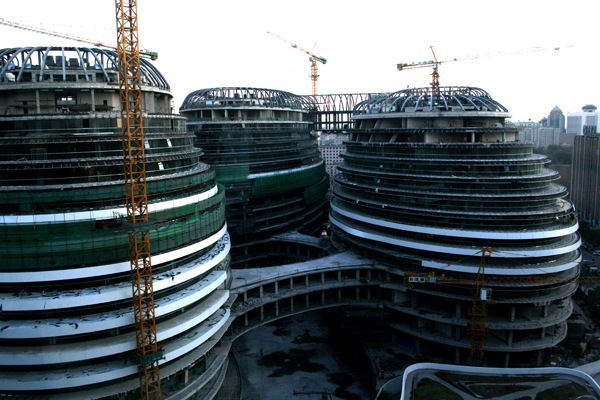The changing face of Beijing architecture - Galaxy Soho
- By William Wang
 0 Comment(s)
0 Comment(s) Print
Print E-mail
CRI, December 5, 2011
E-mail
CRI, December 5, 2011
 |
|
The construction site of Galaxy Soho [Photo: CRIENGLISH.com/William Wang] |
Cruising down the east side of the second ring road, you can't help but notice the oddly curvaceous terraces of concrete slowly sprouting into four globular alien forms. The banners plastered over the boundary fence proclaim with caps locked font that this is GALAXY SOHO, one of Beijing's newest installments of the Soho franchise. Shelves of concrete are just beginning to take on their pristine white veneer, giving hints about what Galaxy is quickly becoming. But what it’s becoming is drawing widely disparate opinions, depending on who you talk to.
Galaxy Soho will be a massive office and retail building designed by internationally acclaimed Zaha Hadid Architects, Zaha Hadid being one of today's celebrity architects. Time Magazine recently proclaimed her as one of their one hundred most influential people on our planet, for her personality as much as her flowing designs. ZHA made a prominent mark on China last year with the influential Guangzhou Opera House, pushing the architecture envelope in a city that's already moving in fast forward. In Beijing as in Guangzhou, ZHA’s Galaxy Soho stands out as a beacon of modernity, arguably in defiance of tradition and local history. This is a building which contrasts sharply with its surrounding humble hutongs (Beijing’s traditional alleyways).
Four flowing round shapes stretch out for each other, forming passageways and bridges. There is something otherworldly in the 330,000 square metre design of Galaxy Soho; indeed many viewers feel as if the structure has dropped in from outer space. But the architectural director of the project, Satoshi Otashi argues that this interpretation doesn’t fully reflect the intention of the design: “This project isn’t alien in the sense that the shapes are more organic or soft. They’re actually inspired by the natural environment, things that we see from the natural landscape…The whole project is a series of these layers…and of terracing to create a landscape within the city, an urban landscape which was inspired by the natural landscape.”
Satoshi explains that the design in fact directly pays homage to Chinese culture. Not only do the horizontal planes mimic terraced rice paddies; the space held within each building module can be compared to the spaces in traditional Chinese courtyards. People may not consciously make those comparisons when gazing upon these monolithic bulbous shapes, but somehow there is something that feels familiar in them.
Still, it’s obvious that the building is doing something new, from it’s lack of right angles to the way it’s laid out. Ohashi continues, “[Galaxy Soho has] these volumes that are fused or linked together. On one hand, it’s not just a series of independent building blocks like you often find in Beijing--big square blocks. We tried to create softer shapes that fuse together to create a bigger whole, so there is a sense of [Galaxy Soho’s] big scale responding to the big scale of the city.”
Listening to Ohashi speak, it quickly grows evident that Galaxy Soho has been carefully designed in every aspect to respond to the current cultural, economic and geographic climate of downtown Beijing. But that won’t necessarily allay its critics.
One anonymous local resident commented sadly on the disappearance of hutongs and history in the downtown core. “Beijing has a history of 5000 years. Modern buildings cannot signify Beijing’s culture and image... Such buildings should be built outside Fourth Ring Road and Fifth Ring Road.” Resident Lei seemed befuddled by the design, saying, “For me, it's not clear where things are. I think maybe straight, square buildings would be better.”
Other local residents welcome the project. Local parking lot attendant Zheng Shoulai said, “It’s beautiful. Of course I like it, but I cannot live in it.” Resident Wei Zhun Ling said, “In Beijing there's nothing else like it. It's better than the Bird's Nest. It's better than the CCTV Building, because that one doesn't feel safe. It might fall down. This one: look. It's very safe. Even in a big earth quake it should be okay. Safe and beautiful.”
Galaxy Soho is located at the Chaoyangmen subway station. It will open its doors to the public in 2012.






Go to Forum >>0 Comment(s)